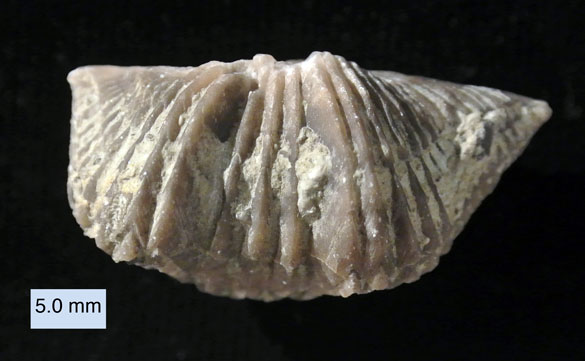Kevin Silver (’13), a sharp-eyed paleontology student, found this odd brachiopod on our field trip earlier this month in southeastern Indiana. It comes from the Upper Ordovician (Katian) Whitewater Formation. Kevin correctly identified it as Vinlandostrophia acutilirata (Conrad, 1842), an orthid brachiopod formerly in the genus Platystrophia (see Zuykov and Harper, 2007). The above view is looking at the anterior of the brachiopod with the dorsal valve above and the ventral valve below.
What we see right away is that this brachiopod specimen is asymmetric: the right side is much shorter than the left. This is a feature of this individual, not the species. Is it a teratology — a deformity of growth? Probably. It is unlikely to be from post-depositional squeezing because the shell is otherwise in excellent shape. The oddity did not seem to hinder this individual from growing to a full adult size.

The same specimen looking at the dorsal valve with the hinge at the top of the image. The fold in the center is coming up towards us.

The posterior of our specimen, with the dorsal valve at the top. This is the hinge of the brachiopod.
(The above images are to help my paleontology students with their brachiopod morphology!)
References:
Alberstadt, L.P. 1979. The brachiopod genus Platystrophia. United States Geological Survey Professional Paper 1066-B: 1-20.
Boucot A.J. and Sun, Y.L. 1998. Teratology, possible pathologic conditions in fossil articulate brachiopods: p. 506-513, Collected works of the international symposium on Geological Sciences, Peking.
Conrad, T.A. 1842. Observations on the Silurian and Devonian Systems of the United States, with descriptions of new organic remains. Journal of the Academy of Natural Sciences of Philadelphia 8: 228-280.
Zuykov, M.A. and Harper, D.A.T. 2007. Platystrophia (Orthida) and new related Ordovician and Early Silurian brachiopod genera. Estonian Journal of Earth Sciences 56: 11-34.





Pingback: Phylum Brachiopoda: The Lamp Shells (September 25 & 27) | Invertebrate Paleontology at Wooster
I found a same deformed Brachiopod in Saudi Arabia, near Riyadh. The deformation was very symatric. Sure it is coincidence?
Could be a pattern, Frederik!